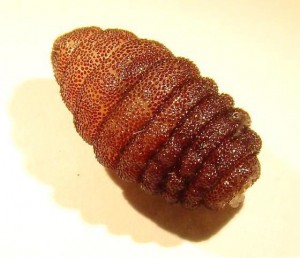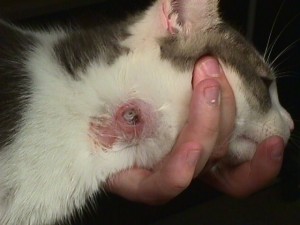When I was seven years old my parents let me pick a puppy from the shelter. I practically chose the first puppy I saw and she was my best friend for just short of 16 years. But within a few weeks of her adoption she chewed all of the hair off of a spot on her chest. We brought her to the veterinarian and within a couple minutes of him disappearing to the dreaded “back room” he returned with a small (but enormous by 7 year old standards) bloody bug on a piece of gauze. It was the coolest thing I ever saw and the next day I wanted to be a veterinarian.

The insect
Cuterebra refers to a group of large parasitic flies that undergoes parasitic larval development in rodents or rabbits. As such, adult female flies lay their eggs around the entrances to dens, nests, or along runways used by their host species. However, cats and dogs can become accidental hosts when they brush against the eggs. Eggs in the fur will hatch after being stimulated by the host’s body heat. The insect will then enter into the host either through the mouth, nose, or open wounds. Once inside the host, the larvae will travel to a species specific location in the subcutaneous tissue (space between skin and muscles). The insect will form a breathing hole through the skin, and within 30 days it will mature and exit from the host where it will enter the soil in order to pupate into an adult fly.
Clinical findings
Typical infections manifest as an approximately 1 cm fistulous swelling in the head, neck, or trunk. Cats will aggressively groom the area and it may or may not be painful depending on the presence of secondary infection. Aberrant migrations manifest as abnormal signs in the area of migration which can include the brain, spinal cord, eyes, nasal passages, and or pharynx. Ocular migrations can manifest as chemosis, blepharospasm, uveitis, or blindness. Nasal or pharyngeal migrans can manifest as upper respiratory infection, nasal discharge, or coughing. Neurologic migrans are more often observed in free roaming cats in late summer. Signs can include depression, seizures, lethargy, central blindness and vestibular disease. Neurologic manifestations are often preceded by an episode of violent sneezing weeks to months before signs develop.

Treatment
To remove the larva, carefully probe and enlarge the breathing hole with a pair of small (e.g. mosquito) hemostats. Covering the bot with lubricant for 10-15 minutes may facilitate bot removal as it encourages the bot to seek air. Do not squeeze the larvae as rupturing it can cause a chronic foreign body reaction or secondary infection. After removal, flush the wound with sterile saline and debride if necessary. The wound should be allowed to heal open, no stitches are required. Antibiotics may be required in severe infections, but after removal of the larvae many animals heal quickly. When the bot cannot be removed, treatment is more challenging. Ivermectin has been used for cats with CNS cuterebriasis, but in some instances progression occurs too quickly.
Conclusion
Cuterebra are fairly common external parasites of domestic animals, especially cats and kittens in summer. Identification and removal of the bot is essential for successful treatment. While most animals present with draining wounds, keep cuterebra in the back of your mind for unusual neurological or ocular cases. Have you seen any interesting cases of cuterebriasis? Post your brags and horror stories below, and we’ll see you next week!


Can cuterebra manifest very early and have a breathing hole that is only 1-2mm across and no bot found when the vet tried to remove it? The case in question is my 12-14 year old rescue chow mix who now has a surgical incision to heal and no bot to show for his trouble. Thank you.
Hi Beth, thanks for the question! Cuterebra can be very small, even <10mm at first. It is entirely possible that the first sign of a bot would be a tiny hole. When your vet explored the wound surgically and found no bot, grass seed, or other foreign body then that may indicate that the wound is due to something else. Other things which can cause draining tracts include fungal infections, cancer, allergies, antibiotic resistant bacteria, and even fragments of broken bone! Hard to say any which way, but I would recommend watching the draining tract to see if it heals or worsens, and seeking further diagnostics with your veterinarian. Cheers, Tiva
Ivermectin is the drug of choice not only for cerebral cuterebriasis but also for the subcutaneous one. Am a vet doctor and I have seen it work in most of my cases